A mosque is a mosque is a mosque, right?
Wrong! You could perhaps be forgiven for thinking in this way while travelling around Turkey where too many modern mosques are mere cut-price, cut-down copycats of the great Sinan originals. In reality, though, Turkey is home to a huge variety of mosques, many of them truly splendid. Nor is it only the larger mosques that are worthier of attention: in several parts of the country and especially around Denizli and Rize there are small local mosques that look completely ordinary on the outside but turn out to be lavishly decorated on the inside.
The following are some of the country’s finest mosques but have also been chosen as representatives of different styles from different periods.
Ulu Cami, Diyarbakır
Dating back to 639 and the period when the newly invigorated Arabs were pouring north from what is now Saudi Arabia, the Ulu Cami in far eastern Diyarbakır is believed to be the oldest mosque in Anatolia. With its elongated courtyard surrounded by the mosque itself and several porticoes, its design has more in common with those of Aleppo and Damascus than it does with later Turkish designs. The mosque has gone through regular rebuildings over the centuries and has been undergoing meticulous restoration for many years.
Alaaddin Cami, Konya
The most familiar Turkish mosque design features cascading domes and semi-domes framed by minarets but many of the oldest mosques in the country have a much less showy appearance. As in their caravanserais, the Selçuks tended to focus all their decorative efforts on the portals of their mosques and on the mihrabs inside which usually sat amid a sea of columns, often utilising pieces of Roman masonry as capitals and bases. The Alaaddin Cami in Konya, the original Selçuk capital, boasts an unusually elaborate exterior although its interior is fairly typical, Buried in the courtyard behind it are some of the Selçuk rulers.
Ulu Cami, Divriği
After the Selçuk Sultanate of Rum (Konya) collapsed many different emirates (beyliks) developed in Anatolia. Remote Divriği became the capital of the Mengücek Beylik, one of whose rulers, Ahmed Şah, commissioned an Ulu Cami of such splendour in 1228 that it is now one of Turkey’s world heritage sites. What makes his Ulu Cami so particularly special is the Cennet Kapısı (Heaven Gate) that took the usual Selçuk emphasis on portals to such wildly elaborate extremes that can be described as a form of Selçuk Rococo. There’s nothing else quite like it in Turkey although a copy has been added to a modern mosque at Bulancak, near Giresun on the Black Sea. 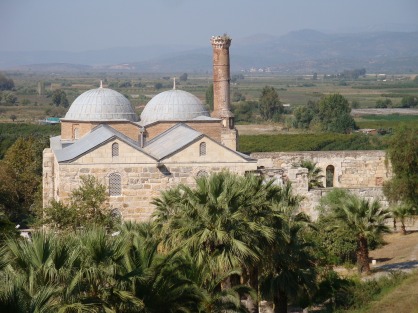
İsa Bey Cami, Selçuk
Tourists who choose to visit the ruins of Ephesus from Selçuk rather than Kuşadası also get the opportunity to appreciate another masterpiece of the Beylik period: the huge and lovely İsa Bey Cami, built in 1375. Despite its position on the far western side of Turkey this mosque bears some comparison with the Ulu Cami in Diyarbakır, having a large courtyard in which the congregation once prayed out of doors in summer. In general the mosque is seen as an example of the transition from Selçuk to Ottoman architecture, with the elaborate decoration of the portal harking back to the Selçuks while the twin domes presaged the early Ottomans.
Eşrefoğlu Cami, Beyşehir
On the shores of Lake Beyşehir, the Eşrefoğlu Cami is another masterpiece of the Beylik era that belongs to a distinct subset of “Selçuk” mosques nicknamed “forest mosques” because the great sea of columns inside them was created from wood rather than stone. Built in 1299, this mosque features not just forty-two lovely wooden columns but also an array of other painted wooden fittings including the mimber and seating boxes for the muezzin and the emir himself. Right in the middle a square is fenced off with wooden balustrades. Once upon a time it would have been open to the skies although it’s now roofed over.
In 2023 a group of forest mosques became a world heritage site. Along with the Eşrefoğlu Cami, they arei the Ulu Camis in Afyon and Sivrihisar, the Arslanhane Cami in the Samanpazarı area of Ankara, and the Mahmud Bey Cami in remote Daday, near Kastamonu. Only slightly less impressive examples are Ahi Elvan Cami, also n the Samanpazarı, and the Alaadin Cami in Bor.
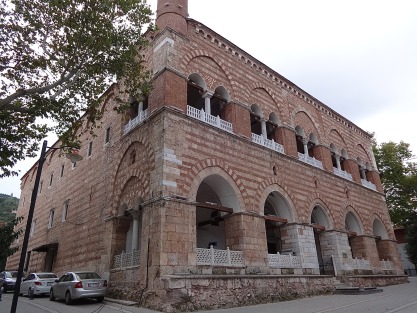 Hüdavendigar Cami, Bursa
Hüdavendigar Cami, Bursa
When the Ottomans first started to take over Anatolia the mosques they designed were far simpler than those that were to come later. Many fine examples can be seen in Bursa, the first Ottoman capital, where a ground plan based on an inverted T developed, with the mihrab up a few steps in the narrowest part of the mosque. Featuring brick-and-stone exteriors, the mosques often look almost Byzantine. With its many domes built onto a flat roof, Bursa’s Ulu Cami is the least typical mosque in town. More characteristic is the iconic Yeşil Cami with its fine tiled interior. Tucked away in the Çekirge suburb, the Hüdavendigar Cami, built for Sultan Murad I between 1363 and 1366, is another impressive one-off, its exterior so designed that it looks almost like a Byzantine palace rather than a mosque. Inside, it reverts to the typical T-bar design. It’s a shame that more people don’t visit it.
After the Ottomans seized Constantinople from the Byzantines in 1453 they had to improvise places of worship from existing buildings, which meant quickly converting all the Byzantine churches into mosques. These church-mosques included both Hagia Sophia (Ayasofya) and the Chora Church (Kariye Cami) but there are many other church-mosques in the old city too. One particularly lovely example is Küçük Ayasofya, which started life in 527 as the Church of Sts Sergius and Bacchus. Externally it’s not especially striking but step inside and you’ll find a two-storey ring of marble columns etched with fine carvings and a lengthy inscription. It’s a splendid one-off.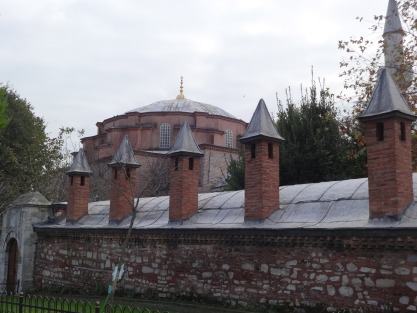 Küçük Ayasofya
Küçük Ayasofya
Süleymaniye Cami, Istanbul
Of all Turkey’s architects none has the name recognition of the great Mimar Sinan (c.1490-1588). Today more than eighty of the buildings he designed for İstanbul still survive, including medreses, hamams and bridges. But it is his many mosques that have left the greatest mark on the city and of those mosques it is the Süleymaniye, the great mosque that he built for Süleyman the Magnificent and that bestrides the skyline, that is the most impressive, not least because almost all of its original külliye, the collection of social buildings surrounding it, survives.
The Süleymaniye is huge, splendid and crowded, and some visitors prefer the much smaller Rüstem Paşa Cami that hunkers down in Tahtakale near the Galata Bridge, its walls papered with lovely İznik tiles on the inside and out. There are more fine tiles in the Sokollu Mehmed Paşa Cami in Kadırga but my own personal favourite Sinan mosque is the Şehzade Cami at Saraçhane, the first large mosque complex he designed.
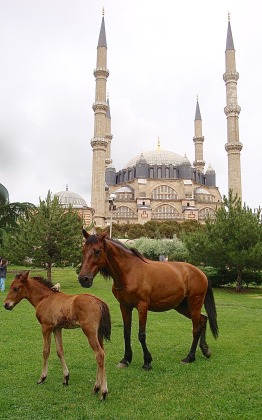 Selimiye Cami, Edirne
Selimiye Cami, Edirne
Much as the Süleymaniye is admired, Sinan himself rated the Selimiye Cami that he built for Sultan Selim II in Edirne between 1569 and 1575 as his masterpiece, a decision confirmed by UNESCO when it awarded the mosque world-heritage-site status in 2011. Set at the back of a small park that makes it easy to appreciate it, the Selimiye incorporates all the familiar Sinan characteristics – a central dome covering a huge central prayer hall with a collection of smaller domes and semi-domes surrounding it and four tall, thin minarets framing it.
Sultanahmet Cami (Blue Mosque)
Designed by a pupil of Sinan, Sedefkar Mehmet Ağa, between 1609 and 1616, the Sultanahmet Cami is as grand as, and similar in design to, the Süleymaniye, and features an unrivalled selection of İznik tiles. But where Sultan Süleyman had been happy to settle for four minarets, Sultan Ahmed I wanted an even more impressive six. For that alone the Sultanahmet Cami stands out. It wasn’t until the Merkez Sabancı Cami arose in Adana in 1998 that a second mosque in Turkey also opted for six mosques. The Çamlıca Cami did the same thing in 2019.
Ortaköy Cami, İstanbul
Most commentators think that Turkish mosque architecture went into a slow decline from the end of the 17th century onwards. In the latter half of the 19th century, however, the prolific Balyan family of architects bestowed a distinctive set of mosques on İstanbul, especially on the shores of the Bosphorus. Typical of these mosques is the Büyük Mecidiye in Ortaköy, built in 1855 and now sitting just beneath the Bosphorus Bridge. Whereas the windows of Sinan mosques tended to be relatively small and were often filled with stained glass, this mosque has huge, arched windows designed to draw in light from the outside. By this time the baggage of the social buildings once associated with mosques had been shed along with the cascading domes and semi-domes. Instead the Ortaköy Cami features a single large dome along with two minarets. The Dolmabahçe Cami is more or less a mirror image of it.
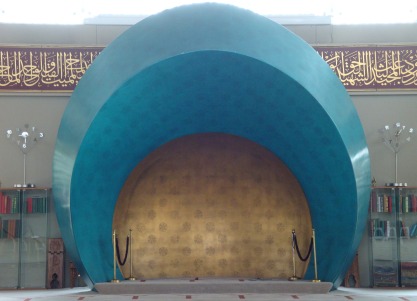 Şakirin Cami, İstanbul
Şakirin Cami, İstanbul
Modernity has not been kind to İstanbul mosque design, little of which rises above mediocrity. A striking exception is the Şakirin Cami on the edge of the Karacaahmet cemetery between Üsküdar and Kadıköy. Completed in 2011, this is a mosque that nods towards Frank Gehry on the outside. On the inside, however, it’s unique. The work of a female interior designer, Zeynep Fadıllıoğlu, it features a magnificent turquoise and golden mihrab together with beautiful goldleaf calligraphy and dripping plastic chandeliers. It’s well worth going out of your way to see.


